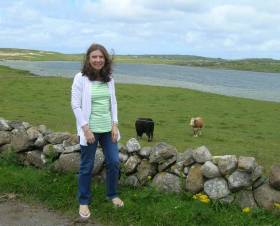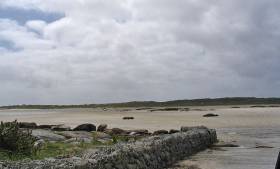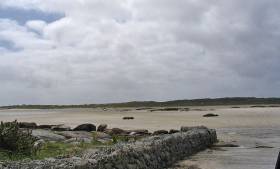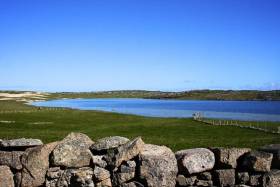Displaying items by tag: Omey Island
Clifden Lifeboat Rescues Three Walkers Cut Off by Tide at Omey Island
Clifden RNLI’s volunteer crew were tasked by the Irish Coast Guard at 1.45pm on Tuesday (26 October) following a report that three people were stranded on Omey Island.
The Atlantic 85 inshore lifeboat was launched by volunteer helm Kenny Flaherty with Joe Acton and Neill Gallery as crew.
Weather conditions were good with calm seas and the lifeboat crew had no difficulty locating the walkers on Omey Island.
The casualties were found to be well and did not require medical assistance. They were returned to the shore at Claddaghduff where Cleggan Coast Guard provided further assistance.
Speaking after the shout, Clifden RNLI lifeboat operations officer John Brittain said: “We would remind locals and visitors to always check tide times and heights before venturing out to Omey and to always make sure you have enough time to return safely.
“If you do get cut off by the tide, it is important to stay where you are and not attempt a return to shore on your own as that may be when the danger presents and you get into difficulty.
“Always carry a means of communication and should you get into difficulty or see someone else in trouble, dial 999 or 112 and ask for the coastguard.”
Inishbofin Campaigner Supports Omey Islander Descendant's Call for Remains to Be Returned
A descendant of Omey islanders has demanded that all remains of human burials removed in an emergency excavation from the Connemara island’s graveyard be returned.
As The Sunday Independent reports, Maggie Coohill has said she is “disappointed and disgusted”, and very frustrated at the response to queries she has submitted in relation to the location of up to 60 skeletons taken from Omey graveyard in the early 1990s.
Support for Coohill and the Omey descendants has been voiced by Marie Coyne, who led the campaign to have skulls held at Trinity College, Dublin, returned for burial on Inishbofin.
“The Omey remains must be returned as soon as possible to Omey island, as this was their resting place and must be again,” Ms Coyne told The Sunday Independent.
“By now, some 30 years since they were removed, enough tests must have been done on them, and also remember these people did not donate their bodies to medical science,” Ms Coyne said.
“These people have suffered enough in life and deserve a proper burial; they deserve respect,” she said.
The excavation at Omey Island, led by Prof Tadgh O’Keeffe of University College Dublin, was commissioned in the early 1990s after storm damage, coastal erosion, and rabbit burrowing exposed several graves on the Omey shoreline which were at risk of being washed into the Atlantic.
Ms Coohill and several of her cousins have spent the last nine years campaigning for their return after an appeal by her late father, who was one of the tidal island’s last full-time residents.
Just over a year ago, the State’s chief archaeologist Michael MacDonagh apologised to the Omey, Cleggan and Claddaghduff communities for lack of communication over the past three decades on the issue.
Mr MacDonagh said at a public meeting in the summer 2022 that there was no evidence of material from recent burials having been taken during the excavation. He said that research was continuing on the skeletons dating from the 7th to 15th century.
Ms Coohill said she was not happy with the level of communication since this meeting and objected to the suggestion that the skeletons would be kept in the care of the State rather than being reburied as had been originally promised.
A spokesman for the National Monuments Service said it had been in contact with Ms Coohill and informed her that human archaeological remains excavated from Omey island had been recently transferred from UCD to the National Museum Collections Resource Centre in Swords, Co Dublin, where they were being re-catalogued and analysed.
“Discussions with the National Museum on potential reburial of some of the remains will take place following the completion of necessary full analyses of the remains,” the spokesman said.
Read more in The Sunday Independent here.
Clifden RNLI’s volunteer crew launched the Atlantic 85 inshore lifeboat on Monday afternoon (24 October) to assist nine people who were caught by the tide on Omey Island in western Connemara.
Malin Head Coast Guard requested assistance from Clifden RNLI just before 4pm and the lifeboat launched immediately after under the command of volunteer helm Kenny Flaherty.
Weather conditions at the time were poor with heavy rain. However the nine people stranded on the island were found to be well and in good spirits.
The lifeboat crew proceeded to make two trips with the casualties back to the shore at Claddaghduff and safely returned all nine people to the mainland.
Speaking after the shout, Clifden RNLI lifeboat operations officer John Brittain said: “We would remind locals and visitors to always check tide times and heights before venturing out and to always make sure you have enough time to return safely.
“If you do get cut off by the tide, it is important to stay where you are and not attempt a return to shore on your own as that may be when the danger presents and you get into difficulty. Always carry a means of communication and should you get into difficulty or see someone else in trouble, dial 999 or 112 and ask for the coastguard.”
Cleggan Coast Guard team were tasked earlier in the week to a collapsed horse on Omey Island off Claddaghduff in western Connemara.
The fallen horse was in grave danger with a fast incoming tide, so the coastguard team members worked quickly with assistance and guidance from two vets from Western Veterinary and the owner to bring the horse safely ashore.
Cleggan Coast Guard later commented on social media: “Thankfully the horse is doing well. We’re delighted to be part of this unusual rescue.”
Also this week, Cleggan Coast Guard welcomed Minister of State and Galway West TD Hildegarde Naughton to its base in north-western Co Galway.
 Minister of State Hildegarde Naughton is presented with a locally made miniature model currach by Cleggan Coast Guard
Minister of State Hildegarde Naughton is presented with a locally made miniature model currach by Cleggan Coast Guard
During her visit, the minister was shown the range of services and facilities the volunteers at Cleggan provide for Connemara, including a demonstration by the unit's drone search team.
In honour of her visit and in light of the minister’s Department of Transport leadership of the Irish Coast Guard, Minister Naughton was presented with a locally made miniature model currach.
Officer in Charge Michael Murray commenting on the visit said: “It’s great to see the minister make such an effort to get out and meet the people who volunteer their time. We are so proud that she is a TD for our constituency as well.”
Moves Made by State to Return Bones Taken in Emergency Dig on Omey Island 30 Years Ago
Relatives of Omey islanders have renewed their appeal for a return of bones taken by the State in an emergency excavation three decades ago.
As The Sunday Times reports, a professor of archaeology has been contacted about human remains removed from Omey off Claddaghduff in Connemara in 1992, which residents have campaigned for years to be returned.
The Department of Housing, Local Government and Heritage said last week that it had approached Tadhg O’Keeffe, a University College Dublin professor, to discuss his excavation on the Co Galway tidal island and “the matter of the burials in the context of the local interest”.
It told the newspapers it has received “a suite of technical reports” from O’Keeffe. The documents will be reviewed by the National Monuments Service and National Museum of Ireland.
The department said the remains analysed so far dated from the early medieval period and Bronze Age, “not to recent burials”.
Maggie Coohill, whose father was born on Omey, said: “Islanders were told in the early 1990s that these bones would be returned. They didn’t expect they would still be waiting 30 years later.”
Conservation expert Deirdre McDermott said she had been asked to pursue the issue on behalf of Cleggan Claddaghduff Community Council.
She is a local resident and former president of the Irish national committee of International Council on Monuments and Sites (ICOMOS), and involved in its working group on rights-based approaches.
“Omey is an important site, with burials there straddling two millennia, but the local community supported an emergency archaeological dig and removal in good faith, on the understanding the bones would be reinterred in due course,” she said.
“Even as recently as 2019, the UNESCO World Heritage Operational Guidelines were changed to acknowledge community participation, and rights,”McDermott said.
Prof O’Keeffe said the return of the material was in the hands of the State’s chief archaeologist Michael McDonagh.
O’Keeffe also said that the first paper in a planned series of five articles outlining the results of the research had been published in the Journal of the Galway Historical and Archaeological Society.
Asked if the community had been informed, he said both he and McDonagh had discussed producing a small booklet on the island’s archaeology when the last or second last scientific paper has been published.
Read more in The Sunday Times here
Clifden RNLI came to the aid of two walkers who got cut off by the tide yesterday evening (Sunday 11 April).
The volunteer crew were requested to launch the lifeboat by the Irish Coast Guard at 5.50 pm following a report that two people were stranded on Omey Island.
The inshore Atlantic 85 class lifeboat helmed by Kenny Flaherty and with three crew members onboard, launched immediately and made its way to the scene.
Weather conditions at the time were good with a northerly Force 5 wind.
Once on scene, the lifeboat crew checked that the two people were safe and well before proceeding to transfer them on to the lifeboat and bring them back to shore at Claddaghduff.
Speaking following the call out, John Brittain, Clifden RNLI Lifeboat Operations Manager said: ‘The two walkers were not in any immediate danger and we were happy to help and bring them safely back to shore.
‘We would remind locals and visitors to always check tide times and heights before venturing out and to always make sure you have enough time to return safely.
‘If you do get cut off by the tide, it is important to stay where you are and not attempt a return to shore on your own as that may be when the danger presents and you get into difficulty. Always carry a means of communication and should you get into difficulty or see someone else in trouble, dial 999 or 112 and ask for the Coast Guard.’
Connemara's Omey Island Petition to Return Bones Taken During Archaeological Excavation
On the eve of Connemara’s Omey island races, relatives of islanders have initiated a petition seeking the urgent return of bones removed during an archaeological excavation writes Lorna Siggins
Minister for Culture Josepha Madigan has also been urged to intervene to ensure that the bones, excavated in the 1990s, can be brought back for a Christian burial.
Ms Maggie Coohill, whose father was born in Omey, says she has spent the last five years seeking action and has now initiated the petition.
“Islanders were promised 30 years ago that these bones of their relatives would be returned,” she said.
Omey, a tidal island off Claddaghduff, lost its last full-time resident when stuntman Pascal Whelan died in 2017. Poet Richard Murphy built a hexagonal granite studio on the island.
Its annual Omey island races across the strand at low tide take place this Sunday from 1 pm
The island has evidence of occupation from the Bronze Age, up to 2000 BC, up to the Great Famine, when there were 400 residents. Its monastic site dating from about the 6th century is named after its founder, St Feichín.
The medieval site, which included one of the few reported burials of a woman within monastic ground, was excavated in the 1990s by Prof Tadhg O’Keeffe of University College, Dublin (UCD) after concerns that rabbits and erosion were causing damage.
The site was one of a number of west coast archaeological features damaged during severe winter storms of January 2014.
Ms Coohill said she was on holidays on Omey with her father when the excavation began on the north side of the island.
“My uncle, my dad and other locals were not in favour of the bones being taken off the island, but were assured that after they had been examined they would be returned to Omey and given a Christian burial,” she said.
“On January 16th, 2014, I contacted Prof O’Keeffe, and he informed me that it was always his intention that the bones would be returned to Omey,”
Ms Coohill said she now believed that “more than enough time” had been spent to conclude the research. She contacted Ms Madigan several months ago and asked her to intervene, and was told the decision was one for the National Museum of Ireland.
The Department of Cultural, Heritage and the Gaeltacht said the excavations in the 1990s were “commissioned by this department due to the damage and irreparable loss that was occurring to the human remains buried at the location”.
“The archaeological excavations confirmed large scale disturbance of the remains on account of erosion and burrowing activity,” it said.
The excavator in UCD is overseeing the completion of the various specialist analyses of the remains,” it said, and “this post-excavation analysis has benefited from advances in analytical and scientific techniques”.
“The department expects to receive final excavation reports later this year, subject to final completion of the specialist analysis, which will ensure that the story of the inhabitants of Omey is told”, it said.
“Any decision on reburial would then ultimately be a matter for the National Museum of Ireland to adjudicate on,” the department said.
The museum’s decision would be predicated on consideration of “all relevant factors.. as per the conditions of the excavation licence issued by this department”, the department said.
Prof O’Keeffe said the full report was almost complete and ready for publication, and as many individuals as possible had been identified by two professional osteologists (bone experts).
He said it was his personal hope to have repatriation in consultation with the National Museum of Ireland.
Publication of the findings would take place in the Galway Archaeological and Historical Society's journal, he said.
Omey Island Loses Its Sole Resident After Long Illness
#OmeyIsland - Omey Island’s last resident has died, as Galway Bay FM reports.
Retired stuntman Pascal Whelan was found at his home on Saturday (5 February) after a long illness, bringing to an end centuries of continuous habitation on the West Connemara tidal island that saw a steep decline in population over the last 100 years.
Whelan was the subject of a book by photographer Kevin Griffin two years ago, according to TheJournal.ie, which charted his rugged lifestyle.
A more recent book plots the remarkable history of Omey Island itself, which at its peak had over 100 residents a century ago, as previously reported on Afloat.ie.
900-Year-Old Brooch Found On Omey Island
#Archaeology - It was quite a turn-up for the books on Omey Island recently as a US student found a 12th-century brooch in the sand on the Connemara tidal island.
As The Irish Times reports, the rare kite brooch was discovered by chance by McKenna McFadden while on a field trip with fellow New York University students led by Michael Gibbons, a local archaeologist.
It's since been identified as being 900 years old, and will be offered to the collection of the National Museum.
Omey Island is also the subject of a new book charting its remarkable history, as previously reported on Afloat.ie.
#OmeyIsland - Omey Island in Connemara is the subject of a new book by a local woman charting its remarkable history.
Strands of Omey's Story by Bernadette Conroy shows there's much more to the lands off Claddaghduff than the annual beach horse race, as Galway Bay FM reports.
Despite not being a true island, as its only cut off from the mainland when the tide is in, Omey has seen its population dwindle from over 100 a century ago to just a single resident in more recent years.
































































